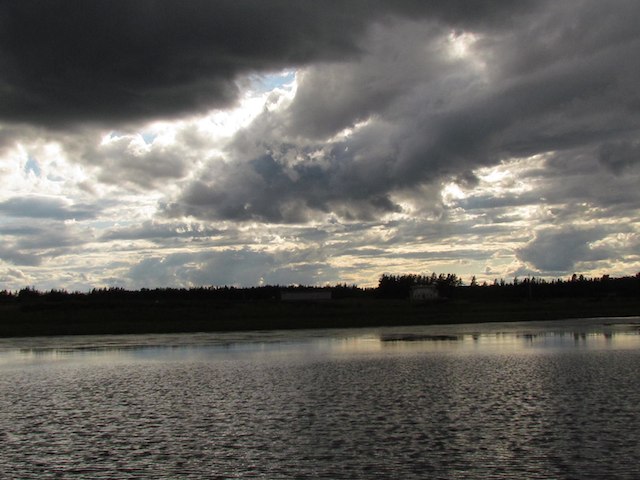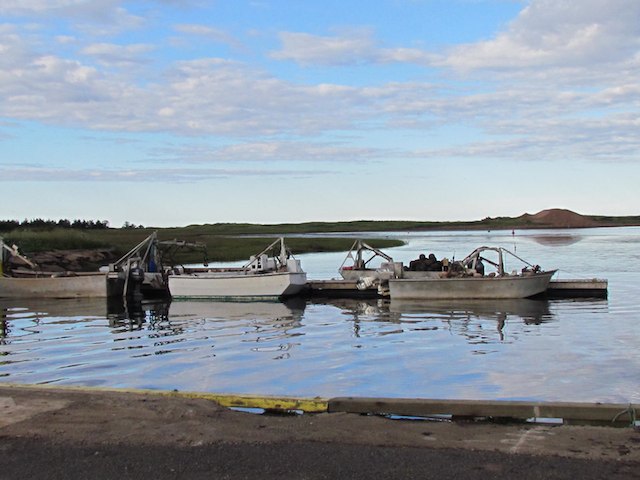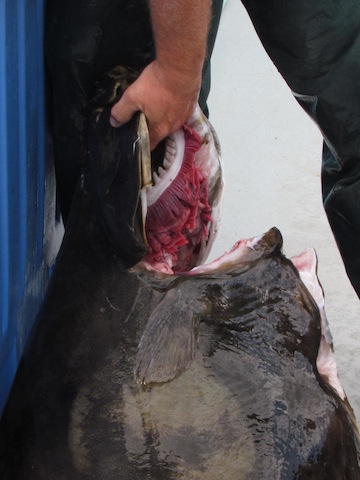August 23, 2011
The Halibut Fishery on PEI is a one day event each summer.
See more photos below.
It was to take place three weeks earlier,
but was rescheduled to August 23.
Fishers must obtain a license to participate.
They may fish between 6:00 am and 6:00 pm.To fish Halibut, fishers set horizontal lines with 100 hooks each extending vertically down towards the ocean floor.
The bait can be mackaral or fresh water clams.
The Atlantic Halibut (Hippoglossus hippoglossus)
is a flat fish that rests on the ocean floor,
half-submerged in the ground, well camouflaged,
because of its dark coloured back.
Two eyes are left protruding a little to watch for the next meal.
The Halibut is a fairly inactive fish, but if a fish swims close by,
it moves swiftly, surging out in an undulating motion and grabbing the prey in its mouth, well equipped with teeth to help make sure nothing gets away.
Halibut can grow very large. According to Wikipedia,
up to 4.7 m. or 15 feet in length and
weigh up to 320 kg. or 700 lbs.
My father-in-law caught one a number of years ago that was 150 lbs., the largest he knew of in this area.
They can live to 50 years of age.
Maturity for reproduction is at 8-12 years
depending on the sex of the fish.
The flesh is white, dense and meaty, and when fresh, coated with flour, and fried gently in butter, is quite delicious with a mild flavour, and a texture that some compare to chicken.
Fishers receive a good price for Halibut, but it is a chancy business as they do have costs to cover and they do not always get a sufficient catch to make it worth while.
The Halibut is a curious fish, in that after hatching it appears as most other fishes do - that is not flat, but swimming vertically, belly towards the ocean floor.
As it grows it soon changes shape.
The left side of the fish becomes the underside,
and the right side becomes the topside.
The left eye migrates around to other side of the head
or what becomes the top of the head.
To achieve this migration it may even do so
by going through the head!
The mouth remains in place so that as an adult it is
arranged vertically, not horizontally on the head of the fish.
One gill is on the top side and the other is on the underside.
The innards of the fish that are removed by the fisher are on the right side, and take up relatively little space.
The spine also changes position to end up about
one-third of the way in from the left side.
The is a large fin one each side of the body.
The body becomes quite thick and meaty especially
as the Halibut grows older.
We went down to the wharf at Savage Bay to wait for
the boats to come in at 6:00 pm.
While being Savagely attacked by mosquitos as we waited,
we enjoyed ....
....seeing some herons, and ducks....
....taking a closeup of one heron....
....finding a starfish in the bottom of a boat....
....admiring the clouds showing off in the west....
....and the view to the northesast and the harbour entrance, with mussel boats in the foreground....
....until the first boat made its way....
.....to the wharf, backing into place to tie up.
The first halibut ....
....a closer view of the head, the deep red tissue
being the inside part of the gills.
The fishers cut the throat to bleed it;
as well they clean out the innards (guts).
The slit can be seen on the right.
A top view of the head.
Towards the middle left of the photo can be seen
the semicircle of the upper gill.
The fish is covered with a thick slime,
which is a protection in the water,
(and also makes it quite slippery to handle!)
The fish is being weighed and the weight
is recorded by an official
of the Department of Fisheries (DFO).
Fishers may also fish cod on this day,
which is also recorded.
These records are used as one of the means
to determine the state of the fish stocks.
This fish weighs about 30 lbs. or 14 kg.
The underside - the sunken part on the left
is where the fish was gutted.
Another top view, showing small white ....
....somethings....
I will have to find out what they are.
If anyone knows, please contact me!
And there are the sharp teeth!
The underside of the jaw, with the gill structure,
held open....
....and here showing the large opening
as it is positioned naturally.
The eyes on top of the head, but the mouth has not morphed around 90 degrees, as did the left eye.
Half the mouth is white, and half is dark.
Finishing to remove the head...
....a bit of a job....
....requiring no little knowledge of the anatomy of the fish....
....to cut through and around the large head bone and spine vertebrae.
The semicircle of the lower gill can be seen above the throat cut, and also a fin, which is matched....
....by a similar dark fin on the top side,
just below the throat cut.
just below the throat cut.
The heaviest fish caught today was about 60 lbs. or 27 kg.
Looking southeast....
....across the bay.
The small white dots are buoys for mussels
that are grown in the bay....
....and more clouds to the west.






























